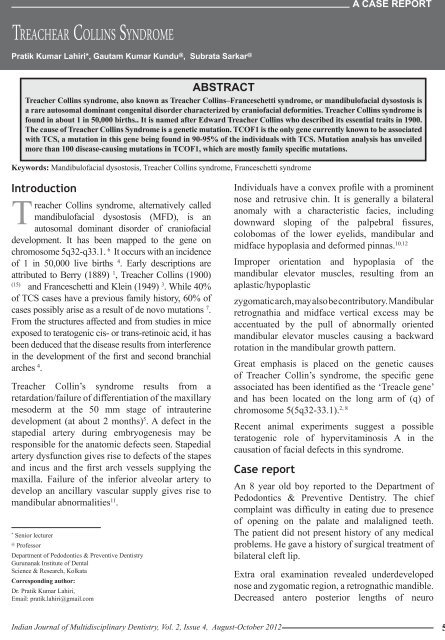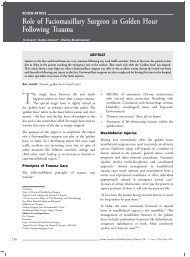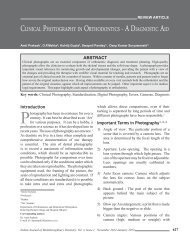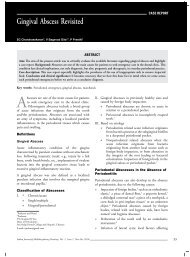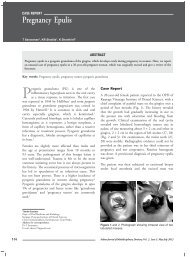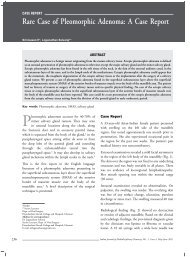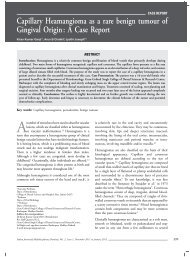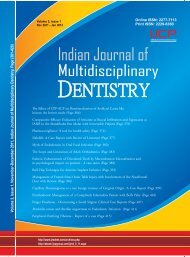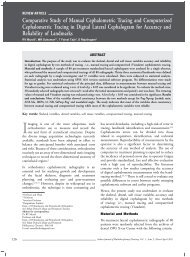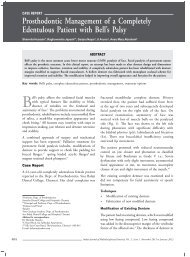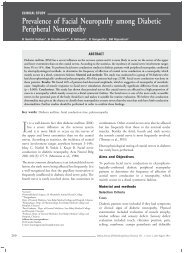Volume 2 - Issue 4 (Aug-Oct) Download Pdf - IJMD
Volume 2 - Issue 4 (Aug-Oct) Download Pdf - IJMD
Volume 2 - Issue 4 (Aug-Oct) Download Pdf - IJMD
- No tags were found...
You also want an ePaper? Increase the reach of your titles
YUMPU automatically turns print PDFs into web optimized ePapers that Google loves.
Treachear Collins Sy n d r o m ePratik Kumar Lahiri*, Gautam Kumar Kundu @ , Subrata Sarkar @A Case ReportAbstractTreacher Collins syndrome, also known as Treacher Collins–Franceschetti syndrome, or mandibulofacial dysostosis isa rare autosomal dominant congenital disorder characterized by craniofacial deformities. Treacher Collins syndrome isfound in about 1 in 50,000 births.. It is named after Edward Treacher Collins who described its essential traits in 1900.The cause of Treacher Collins Syndrome is a genetic mutation. TCOF1 is the only gene currently known to be associatedwith TCS, a mutation in this gene being found in 90-95% of the individuals with TCS. Mutation analysis has unveiledmore than 100 disease-causing mutations in TCOF1, which are mostly family specific mutations.Keywords: Mandibulofacial dysostosis, Treacher Collins syndrome, Franceschetti syndromeIntroductionTreacher Collins syndrome, alternatively calledmandibulofacial dysostosis (MFD), is anautosomal dominant disorder of craniofacialdevelopment. It has been mapped to the gene onchromosome 5q32-q33.1. 6 It occurs with an incidenceof 1 in 50,000 live births 4 . Early descriptions areattributed to Berry (1889) 1 , Treacher Collins (1900)(15)and Franceschetti and Klein (1949) 3 . While 40%of TCS cases have a previous family history, 60% ofcases possibly arise as a result of de novo mutations 7 .From the structures affected and from studies in miceexposed to teratogenic cis- or trans-retinoic acid, it hasbeen deduced that the disease results from interferencein the development of the first and second branchialarches 4 .Treacher Collin’s syndrome results from aretardation/failure of differentiation of the maxillarymesoderm at the 50 mm stage of intrauterinedevelopment (at about 2 months) 5 . A defect in thestapedial artery during embryogenesis may beresponsible for the anatomic defects seen. Stapedialartery dysfunction gives rise to defects of the stapesand incus and the first arch vessels supplying themaxilla. Failure of the inferior alveolar artery todevelop an ancillary vascular supply gives rise tomandibular abnormalities 11 .*Senior lecturer@ProfessorDepartment of Pedodontics & Preventive DentistryGurunanak Institute of DentalScience & Research, KolkataCorresponding author:Dr. Pratik Kumar Lahiri,Email: pratik.lahiri@gmail.comIndividuals have a convex profile with a prominentnose and retrusive chin. It is generally a bilateralanomaly with a characteristic facies, includingdownward sloping of the palpebral fissures,colobomas of the lower eyelids, mandibular andmidface hypoplasia and deformed pinnas. 10.12Improper orientation and hypoplasia of themandibular elevator muscles, resulting from anaplastic/hypoplasticzygomatic arch, may also be contributory. Mandibularretrognathia and midface vertical excess may beaccentuated by the pull of abnormally orientedmandibular elevator muscles causing a backwardrotation in the mandibular growth pattern.Great emphasis is placed on the genetic causesof Treacher Collin’s syndrome, the specific geneassociated has been identified as the ‘Treacle gene’and has been located on the long arm of (q) ofchromosome 5(5q32-33.1). 2, 8Recent animal experiments suggest a possibleteratogenic role of hypervitaminosis A in thecausation of facial defects in this syndrome.Case reportAn 8 year old boy reported to the Department ofPedodontics & Preventive Dentistry. The chiefcomplaint was difficulty in eating due to presenceof opening on the palate and malaligned teeth.The patient did not present history of any medicalproblems. He gave a history of surgical treatment ofbilateral cleft lip.Extra oral examination revealed underdevelopednose and zygomatic region, a retrognathic mandible.Decreased antero posterior lengths of neuroIndian Journal of Multidisciplinary Dentistry, Vol. 2, <strong>Issue</strong> 4, <strong>Aug</strong>ust-<strong>Oct</strong>ober 2012 577


